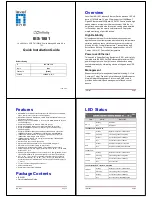
Configuration Guide
TPP Configuration
As shown in the above dual-core topology, A and B are the L3 convergence devices,
and C and D are the L2 access devices. A is the MSTP root bridge. The topology
protection functions of all the devices are enabled.
The CPU of the L3 convergence device A is extremely busy due to network attack,
resulting in that the BPDU packets cannot be sent. The topology protection function
detects the exception and sends the exception advertisement packet to its neighbors.
B, C, and D all receive the advertisement and adopt the anti-vibration measures.
he CPU of B is extremely busy under the attack of a large number of packets and
cannot send or receive packets normally. After detecting the exception, B sends the
exception advertisement to all its neighbors. A receives the exception advertisement
but does not process it further because B finds the exception has not effect on B
according to its source. The downstream C and D receive the exception advertisement
and perform further defense activities to ensure the reliability of the network topology,
because they find the exception will affect the topology calculation.
TPP Configuration
Configuring TPP involves global function configuration and port function configuration.
The global function configuration is used to enable the topology protection function of
the device. By default, the global topology protection function is enabled. Here, it will
detect the running conditions of the local and neighbor devices and perform treatment
for the abnormities that occur. However, it does not notify the local running conditions
to neighbor devices. The port function configuration is used to enable the topology
protection function of the port. When the topology protection function is enabled on the
port, it indicates that the opposite neighbor device is concerning about the running
conditions of this machine. When the local device becomes abnormal, this will be
notified to the opposite neighbor device of the port. By default, the topology protection
function is disabled on all ports.
Note
The topology protection function is suitable for the point-to-point link network,
and adjacent network devices must enable the topology protection function.
Besides, during the TPP configuration, you often need to use cpu
topology-limit to configure the threshold for CPU utilization detection. When
the CPU utilization exceeds the threshold, the system generates the topology
protection advertisement. We suggest a middle to high value, such as 50
–70,
so that the TPP can judge the network conditions more accurately. If the
value is too small, the network topology may not switch when it should to
switch due to TPP alarm. If the value is too large, the system may be too
busy to generate the TPP alarm, causing the TPP invalid.
Configuring Topology Protection Globally
The global topology protection function is enabled by default. The
no
option of the
command disables the global topology protection.
Содержание RG-S2900G-E Series
Страница 1: ...RG S2900G E Series Switch RGOS Configuration Guide Release 10 4 2b12 p1 ...
Страница 91: ...Configuration Guide Configuring PoE Configuration ...
Страница 133: ...Configuration Guide EEE Configuration ...
Страница 319: ...Configuration Guide QinQ Configuration ...
Страница 408: ......
Страница 409: ...IP Routing Configuration 1 Static Route Configuration ...
Страница 412: ......
Страница 413: ...Multicast Configuration 1 IGMP Snooping Configuration 2 MLD Snooping Configuration ...
Страница 621: ...Configuration Guide CPU Protection Configuration udp helper 180 4 dhcp client 180 4 lacp 180 4 ...
Страница 757: ......
Страница 758: ...ACL QoS Configuration 1 Access Control List Configuration 2 QoS Configuration ...
Страница 801: ...Reliability Configuration 1 RLDP Configuration 2 TPP Configuration 3 SEM Configuration ...
Страница 901: ...Configuration Guide ERSPAN Configuration ...
Страница 902: ...Web based Configuration 1 Web based Configuration ...
















































